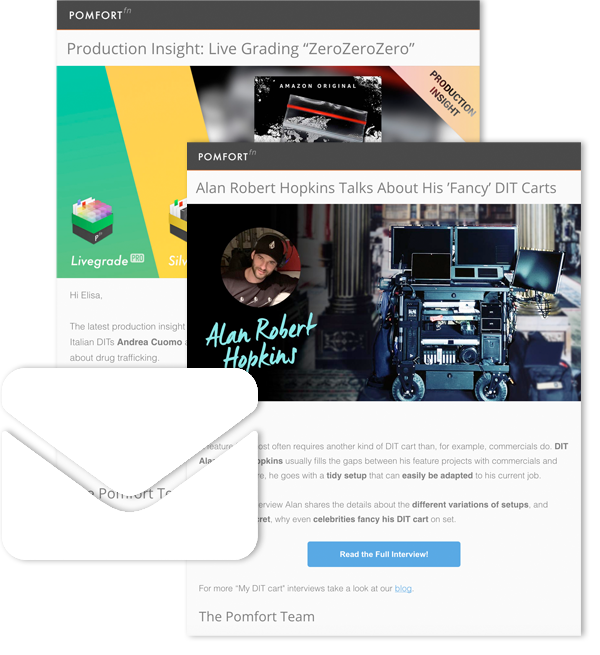
Along the production pipeline, professional film productions rely on elaborate workflows and clever tooling to facilitate the many processes involved. This, of course, also relates to Digital Imaging Technicians, who need an appropriate setup and technical approach. Sure, each production comes with unique requirements and challenges that demand DITs to adapt accordingly. However, the main responsibilities of gathering, structuring, and transferring production data usually persist across projects. So, how do you equip for that?
This article walks you through a (highly simplified) shooting day to outline how Silverstack Lab, Livegrade Studio, and ShotHub work together to solve your digital imaging and asset management needs on set. While it’s clear that additional hardware and software components will always be indispensable to your setup, this product combination takes care of a big chunk of your daily responsibilities. So, let’s start the shooting day and see how it works!
Timeline of a shooting day
The visualization below shows a timeline of a shooting day with critical DIT activities (top) mapped against the involved Pomfort applications (bottom). Greyed-out icons indicate that the respective application isn’t involved in a certain step. Of course, an actual shooting day doesn’t progress that linear and often includes many more aspects, but for the sake of this Pomfort Basics article, let’s keep it simple.

To understand why we’re focusing on the seven steps above, let’s also quickly talk about the desired outcome. What do you, the responsible DIT on set, want to have accomplished at the end of a shooting day? Generally speaking, one can say it’s important to have:
- saved all the looks you worked on together with comprehensive metadata
- copied all OCFs securely
- created a comprehensive metadata library
- prepared dailies for viewing and editing
- documented your day’s work and
- made production information available to all relevant parties on set and beyond
So, now that we have clarified our main goals let’s see how to achieve them with an on-set solution of Silverstack Lab, Livegrade Studio, and ShotHub.
STEP-BY-STEP BREAKDOWN
For the purpose of this article, we begin our shooting day at the point the cameras start rolling, leaving aside the extensive prep work and testing that also goes into a project. If you want to learn more about that aspect, check out this previous article. For now, let’s imagine we’re on set and ready to go!
STEP 1: LIVE GRADING & LOOK MANAGEMENT
Being able to color grade live images on set lets you instantly visualize your DP’s creative intent while shooting. No matter how many cameras are involved, Livegrade Studio allows you to control all live SDI signals with a wide range of device integrations and color grading options. For example, you can quickly apply a show look/LUT that you received from the colorist as a starting point and further modify the image to match the look with the current lighting and the intended mood. All your looks are saved locally in Livegrade’s comprehensive shot library, together with reference media that you create on-the-fly. Revealing the references from your library allows you to compare the look of a previous scene with your current live image, ensuring a consistent look, even throughout month-long productions. By connecting Livegrade Studio to ShotHub, you also make your looks available in the cloud (which comes in handy later on).
STEP 2: OFFLOAD & INGEST
As soon as full camera cards arrive at your workstation, it’s crucial to quickly offload them and create verified backups on multiple volumes. During offload, Silverstack Lab automatically extracts all available metadata and organizes it in a central clip library. Connecting the application with ShotHub enables you to access that metadata remotely via any standard web browser so you can provide information from anywhere and anytime. In addition, you can use ShotHub to create a cloud connection between multiple instances of Silverstack to sync their respective clip libraries (for example, when working with multiple offload stations).
STEP 3: Match Looks
With your shots uploaded from Livegrade Studio to ShotHub, the look matching process becomes really quick and convenient. In Silverstack Lab, you can simply fetch the looks from ShotHub and automatically match them with your clips – no need to manually export and import files. If needed, you can use Silverstack Lab to tweak the looks before starting to transcode.
STEP 4: SYNC AUDIO
Syncing audio is another step that usually takes place in preparation for the dailies creation process. When you ingest separately recorded audio clips into Silverstack Lab, the application automatically syncs them to the corresponding OCFs by timecode. Via ShotHub, you can check and monitor the sync remotely and bring the synced clips to another instance of Silverstack.
STEP 5: EDIT METADATA
Having all media assets in one place makes it easier to stay organized. While most metadata gets automatically extracted and fed into your Silverstack Lab library, you can easily add, adjust, or remove metadata entries. For example, you may want to integrate metadata from external 3rd party sources, like continuity applications, or add further lens info. If you use Silverstack Lab for QC, you can also note your findings in custom metadata fields or assign labels. Thus, you can really tailor your library to your specific needs and requirements. The changes you make are also reflected in your ShotHub cloud project, so everything stays up to date. Again, ShotHub becomes especially useful when multiple offload stations are involved, as all connected Silverstack libraries can be synced.
STEP 6: Transcode
Silverstack Lab comes with a high-performance transcoding engine that lets you create dailies in all required output formats – depending on your needs. For example, you can create one set of dailies for the DP and production to review and differently configured dailies for the editor. All generated clips are available in the Silverstack Lab library and in ShotHub. ShotHub allows monitoring all of this from consecutive production steps, e.g., if all clips have been transcoded, how much data will arrive for the AE each day, or the association of OCF and its transcoded clip.
STEP 7: Share & Report
As the shooting day comes to an end, it’s time to document and report the results of your workday. From the Silverstack Lab library, you can create various report types to share with team members. For example, you can provide overview reports of the entire shooting day or issue detailed reports showing all clips with thumbnails. With ShotHub, your library is also mirrored in the cloud, which enables you to issue reports even away from your workstation (e.g., from your hotel room after wrap). An extremely convenient way to share information is via ShotID: Upon offload in Silverstack Lab, each clip gets assigned a unique identifier and corresponding link. If you connected your Silverstack Lab library to ShotHub, typing in the ShotID into ShotHub’s search field or clicking on the provided link reveals a detailed spreadsheet with all available clip information.
As discussed in the next section, ShotHub further adds new possibilities for transferring production knowledge from the film set to facilities.
STEP 1-7: KEEPING THE FACILITY IN THE LOOP
Once you connect your desktop applications to ShotHub, your gathered production data becomes available in the cloud where authorized people (e.g., at the facility) can access it – even straight after the offload of OCFs or while you are still live grading. This provides a new level of connectivity and transparency across departments and locations, as information already becomes available throughout the different production steps.

For example, the facility can monitor progress and prepare resources accordingly by looking up the amount of shot footage or created transcodes. This ‘pull approach’ also takes a bit of the pressure off the DIT to continuously send all required information. Of course, ShotHub provides many more benefits to facilities, especially when it’s used together with Silverstack Lab. However, to maintain the on-set focus of this article, we won’t go into further details here. If you want to learn more about the facility side of things, check out our detailed Facility Solution page.
ADDITIONAL STEPS
The steps above enable a professional media asset management and digital imaging workflow aimed at the goals we set earlier. However, as mentioned before, we’re well aware that the film set is a highly dynamic environment, and a lot happens in parallel. In addition, it’s likely that your project requires you to pursue additional or different outcomes. For an overview of further options for extending or adjusting your workflow, check out our three-part blog series on working with metadata in the Pomfort ecosystem and beyond. The articles below should give you a good understanding of what else is possible in each application:
CONCLUSION
And that’s a wrap! At least in our little scenario here. As mentioned before, DITs may be responsible for many other things throughout a shooting day, so your actual list and order of activities may differ from the presented steps. But that’s no problem: Since all Pomfort applications are designed to work well together, you can easily scale the discussed on-set solution according to your personal requirements. Don’t need advanced live grading functionalities? Swap Livegrade Studio for Livegrade Pro! Want to involve another offloading station in your setup? Add Silverstack XT! Whatever your digital imaging and media asset management needs, there’s a Pomfort product combination that supports you throughout your shooting day.




